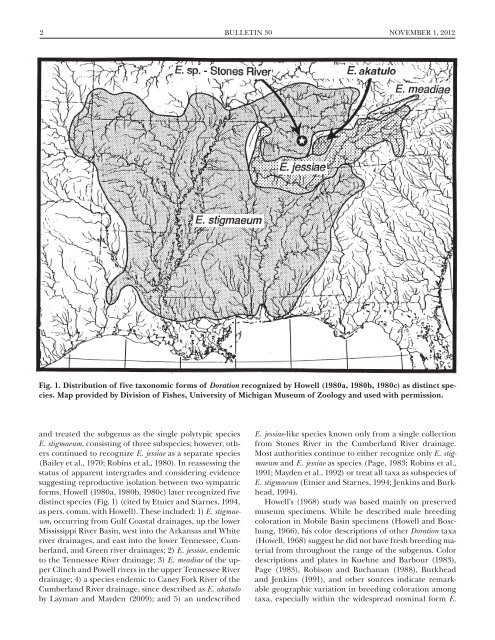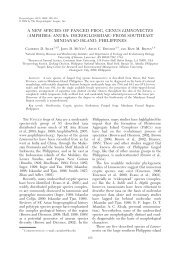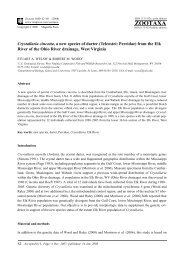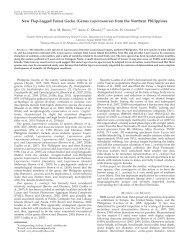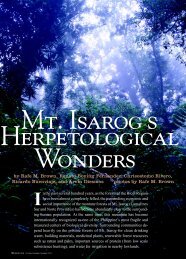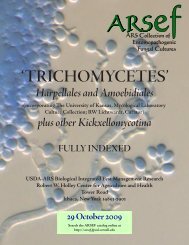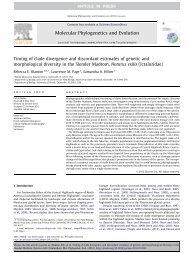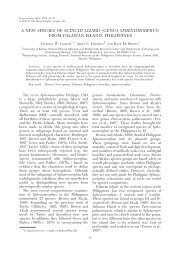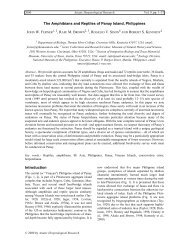(Percidae: Etheostoma), with Descriptions of Five New Species
(Percidae: Etheostoma), with Descriptions of Five New Species
(Percidae: Etheostoma), with Descriptions of Five New Species
- No tags were found...
Create successful ePaper yourself
Turn your PDF publications into a flip-book with our unique Google optimized e-Paper software.
Bulletin 30 NOVEMBER 1, 2012Fig. 1. Distribution <strong>of</strong> five taxonomic forms <strong>of</strong> Doration recognized by Howell (1980a, 1980b, 1980c) as distinct species.Map provided by Division <strong>of</strong> Fishes, University <strong>of</strong> Michigan Museum <strong>of</strong> Zoology and used <strong>with</strong> permission.and treated the subgenus as the single polytypic speciesE. stigmaeum, consisting <strong>of</strong> three subspecies; however, otherscontinued to recognize E. jessiae as a separate species(Bailey et al., 1970; Robins et al., 1980). In reassessing thestatus <strong>of</strong> apparent intergrades and considering evidencesuggesting reproductive isolation between two sympatricforms, Howell (1980a, 1980b, 1980c) later recognized fivedistinct species (Fig. 1) (cited by Etnier and Starnes, 1994,as pers. comm. <strong>with</strong> Howell). These included: 1) E. stigmaeum,occurring from Gulf Coastal drainages, up the lowerMississippi River Basin, west into the Arkansas and Whiteriver drainages, and east into the lower Tennessee, Cumberland,and Green river drainages; 2) E. jessiae, endemicto the Tennessee River drainage; 3) E. meadiae <strong>of</strong> the upperClinch and Powell rivers in the upper Tennessee Riverdrainage; 4) a species endemic to Caney Fork River <strong>of</strong> theCumberland River drainage, since described as E. akatuloby Layman and Mayden (2009); and 5) an undescribedE. jessiae-like species known only from a single collectionfrom Stones River in the Cumberland River drainage.Most authorities continue to either recognize only E. stigmaeumand E. jessiae as species (Page, 1983; Robins et al.,1991; Mayden et al., 1992) or treat all taxa as subspecies <strong>of</strong>E. stigmaeum (Etnier and Starnes, 1994; Jenkins and Burkhead,1994).Howell’s (1968) study was based mainly on preservedmuseum specimens. While he described male breedingcoloration in Mobile Basin specimens (Howell and Boschung,1966), his color descriptions <strong>of</strong> other Doration taxa(Howell, 1968) suggest he did not have fresh breeding materialfrom throughout the range <strong>of</strong> the subgenus. Colordescriptions and plates in Kuehne and Barbour (1983),Page (1983), Robison and Buchanan (1988), Burkheadand Jenkins (1991), and other sources indicate remarkablegeographic variation in breeding coloration amongtaxa, especially <strong>with</strong>in the widespread nominal form E.


